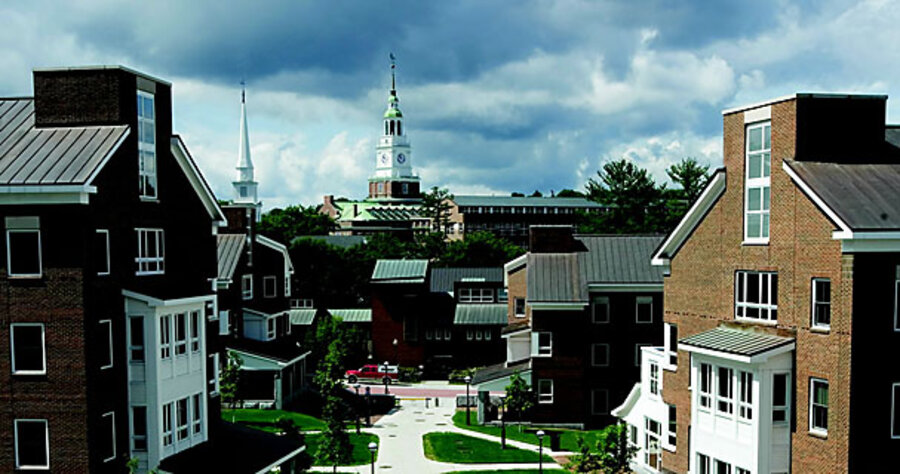Now, ‘green’ report cards for U.S. colleges
Loading...
Students looking to narrow their college choices will soon have something new to consider alongside academics and campus life: A “Green Rating” makes its debut this summer in several of The Princeton Review’s popular college guides. Six-hundred college profiles will include a score reflecting factors such as building and transportation policies, food sources, recycling, and availability of environmental courses.
In response to students’ growing appetite for all things environmentally friendly, several groups have begun tracking schools’ commitment to going green. But such ratings might be productive only to the degree that they spur thoughtful initiatives, pushing schools to collaborate as much as compete, experts say. If it veers toward “keeping up with the Joneses,” some observers caution, it might only increase college costs at a time when affordability is a major concern.
“We’re definitely seeing schools that look at sustainability as a strategic priority and a way of distinguishing themselves, and there are many schools that are striving to be ... the ‘greenest’ campus,” says Julian Dautremont-Smith, associate director of the Association for the Advancement of Sustainability in Higher Education (AASHE) in Lexington, Ky., which has been piloting a rating system in which schools can participate.
The College Sustainability Report Card, put out by the Sustainable Endowments Institute (SEI) in Cambridge, Mass., gives letter grades to at least 200 public and private schools with the largest endowments. In addition to green campus factors, it grades how well a school uses its investment leverage to advocate for the environment. “When people are comparing schools that all say they are leaders on sustainability ... [they can now] peek behind those statements,” says executive director Mark Orlowski.
When Nick Devonshire was a high school senior, he checked the schools on his list against that report card, and Dartmouth College in Hanover, N.H., was his first choice. “In the past year, they had reduced energy consumption by 5 percent while most schools were increasing, and I thought, wow, they’re on top of their game,” he says, after his first year at the college. He also looked at the grades for campus activism and administrative support for environmental efforts.
Many of his peers “want to be at a school where they don’t have to search for recycling ... and where they know they are part of the solution,” says Mr. Devonshire, who’ll be working this summer for the institute.
Six out of 10 college applicants and parents say the environmental factor would affect their decision to apply to or attend a school, according to a Princeton Review survey this year.
The idea of ranking something as broad as environmentalism gives pause even to some considered leaders on this front. “It’s easy to fall into that trap of ‘mine is greener than yours,’ but it is fundamentally inconsistent with the reasons why colleges should be becoming more sustainable.... We’re all part of one system,” says David Hales, president of College of the Atlantic, in Bar Harbor, Maine.
A small campus focused on human ecology, it was the first to become carbon neutral. The environmental news website Grist ranked it top among 15 green colleges and universities last year.
Mr. Hales applauds efforts to make transparent what colleges are doing environmentally, including their mistakes, so others can learn from them. But rather than compete, “the key is to do what you can in a way that makes sense for your own institution,” he says.
Colleges do tend to compete for status, says Richard Vedder, a visiting scholar at the American Enterprise Institute in Washington and director of the Center for College Affordability and Productivity. “Being green and sustainable is trendy these days, but it has the potential to raise costs,” he says. Because of tax subsidies and other factors, higher education doesn’t face enough pressure to control costs, he adds.
To proponents, though, it’s worth spending extra to save money in the long run, particularly with energy efficiency. Some aspects of a green campus are funded by grants, donations, or student fundraisers. But experts say there is no centralized tracking on how much schools spend on these initiatives.
“College and university presidents are weighing those cost-benefit analyses very carefully,” says Melanie Corrigan, director of national initiatives for the American Council on Education in Washington. Many colleges see leadership in this area as part of their social mission, she says.
Debates sometimes arise over how green is green enough.
At Norwalk Community College in Connecticut, some students and faculty have been pushing for changes in plans for a $40 million health and science center to improve aspects such as energy efficiency. It was approved before the state started requiring new buildings to meet standards similar to a silver LEED rating by the US Green Building Council.
“They know that this building is going to be obsolete before they even begin building it,” says Matt Loter, president of the college’s chapter of Student World Assembly, a social justice group. Although LEED certification would be ideal, he says, approximating that criteria is what’s most important.
Mary Anne Cox, assistant chancellor of the Connecticut Community Colleges Board of Trustees, says the building has many features required by LEED standards, but actual certification at this point would increase prices and cause delays. A checklist she supplied indicates the building would score 21 points, about 5 points shy of a basic LEED certification.
Some schools hold “that the relatively modest extra cost [of certification] is worthwhile; others feel if it’s not directly lowering the carbon footprint of a building, it’s not worthwhile,” Mr. Orlowski of SEI says. His group notes that 61 percent of the schools with large endowments have at least one LEED-certified building finished or under way.





